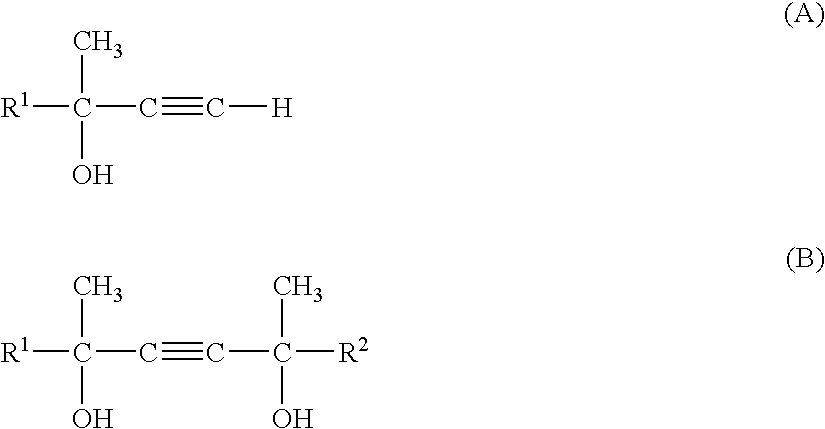Rinse liquid for lithography and method for forming resist pattern using same
a technology of resist pattern and lithography, which is applied in the field of rinse solution composition, can solve the problems the pattern inclination or the pattern peeling after lithography process development, and the problem of limiting the solution method, so as to achieve good pattern, low price, and high safety
- Summary
- Abstract
- Description
- Claims
- Application Information
AI Technical Summary
Benefits of technology
Problems solved by technology
Method used
Image
Examples
example 23
[0039] An anti-reflective coating AZ KrF-17B manufactured by Clariant Company was spin-coated on a 6-inch silicon wafer by a spin coater manufactured by Tokyo Electron Co., Ltd. and pre-baked on a hotplate at 190° C. for 90 seconds to be prepared as forming a film of 800 angstroms in thickness. Film thickness was measured by a film thickness measurement device manufactured by Prometrisc Inc. Next, photoresist AZ DX5160P (“AZ” is a registered trademark, hereafter the same.) manufactured by Clariant Company was spin-coated on the obtained anti-reflective coating and pre-baked on a hotplate at 130° C. for 60 seconds to be prepared as forming a resist film of 0.51 μm in thickness. After that it was exposed to light by a reduction projection light-exposure device, FPA3000EX5 (exposure wavelength 248 nm) manufactured by Canon Co. using ⅔ Annuler. After exposure to light, it was baked on a hotplate at 110° C. for 60 seconds and puddle-developed with a developer, AZ 300MIF Developer manufac...
examples 24 to 44
[0041] The same procedures as in Example 1were carried out except using rinse solutions R-2 to R-22 respectively in place of the rinse solution R-1 to obtain the results in Table 4.
TABLE 4IncidenceRinserate of patternExamplesolutionSurfactantinclination (%)23R-1A024R-2A025R-3A1526R-4B027R-5B028R-6B029R-7B1030R-8C031R-9C032R-10C033R-11C1034R-12D035R-13D036R-14D037R-15D038R-16D1039R-17E040R-18E041R-19E042R-20F043R-21F044R-22F0
example 45
[0043] An anti-reflective coating AZ ArF1C5D manufactured by Clariant Company was spin-coated on a 6 inch silicon wafer by a spin coater manufactured by Tokyo Electron Co., Ltd., and then pre-baked on a hotplate at 200° C. for 60 seconds to be prepared as forming a film of 390 angstroms in thickness. The film thickness was measured by a film thickness measurement device manufactured by Prometrisc Inc. Next, photoresist AZ Exp. T9479 manufactured by Clariant Company was spin-coated on the obtained anti-reflective coating, was pre-baked at 130° C. for 60 seconds to be prepared as forming a resist film of 0.44 μm in thickness. After that it was exposed to light by Stepper NSR-305B (exposure wavelength is 193 nm) manufactured by Nikon Co. using ⅔ Annuler. After exposure to light, it was baked on a hotplate at 110° C. for 60 seconds and puddle-developed with a developer, AZ 300MIF Developer manufactured by Clariant Company (2.38 weight-% tetramethylammonium hydroxide aqueous solution) at...
PUM
| Property | Measurement | Unit |
|---|---|---|
| light-exposure wavelength | aaaaa | aaaaa |
| wavelength | aaaaa | aaaaa |
| thickness | aaaaa | aaaaa |
Abstract
Description
Claims
Application Information
 Login to View More
Login to View More - R&D
- Intellectual Property
- Life Sciences
- Materials
- Tech Scout
- Unparalleled Data Quality
- Higher Quality Content
- 60% Fewer Hallucinations
Browse by: Latest US Patents, China's latest patents, Technical Efficacy Thesaurus, Application Domain, Technology Topic, Popular Technical Reports.
© 2025 PatSnap. All rights reserved.Legal|Privacy policy|Modern Slavery Act Transparency Statement|Sitemap|About US| Contact US: help@patsnap.com

